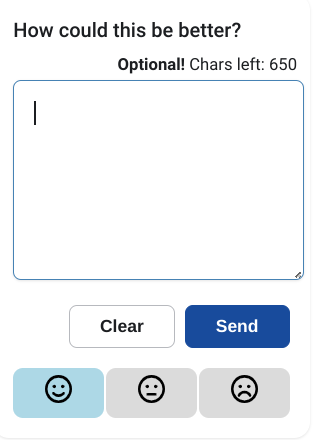The Content Rating Component
The content rating component is powered by Lume 3 Router Middleware and consists of two components:
-
The front-end form & survey component:
comp.feedback(), and, -
The (kinda) back-end admin component:
comp.feedbackAdmin().
The first one produces the form that gathers the vote and optional feedback. It then saves the input to DenoKV (and / or Discord, soon, along with other options).
The second adds a table that lets you manage the feedback (currently, delete).
Anonymous Content Feedback Survey Component
On the right-sidebar of every document page, you'll see a little widget
that lets you express how you feel about reading the current article. That
widget uses the Router middleware to process the form submission and inserts
the feedback into a DenoKV database or anything else that can take input from
a call to fetch(). I plan to have it also work with posting (via Bot) to
Discord. The survey is visible in the right sidebar on every page in /docs;
here it is expanded:

Feedback submits to yourdomain.com/api/feedback via POST request and has a
built-in honeypot. I'm currently investigating possible integrations
with privacy-respecting captcha services.
You can use it in a template like this:
{{ await comp.feedback({ basename: url })}}
or in a MDX post (blog / docs) like this:
<comp.feedback basename={url} />
The basename variable is used literally as the base name of the key
that gets created to store the feedback entry. It's indexed by type,
url. If using the redirects plugin, use the oldest URL of the
group.
You're welcome to use it for the blog too! But perhaps make a copy of
the plugin as blogFeedback and add another locale entry, so you can
have different CTAs, vote buttons, etc.
Anonymous Content Feedback Admin Component
The comp.feedbackAdmin() plugin lets you put an admin area for the
anonymous feedback wherever it's convenient for you to put it.
Designed to run locally only, it works in conjunction with /api/feedback
to get a list of feedback and keys, display it, and provide a convenient means
of deleting it:

It puts a container in the document that receives a table from a
call to fetch() against a route which only works if LUME_DRAFTS
is set.
To use it in a template:
{{ await comp.feedbackAdmin() }}
Or in MDX:
<comp.feedbackAdmin />
Creating A Local-Only '/admin' Route
If you put the following in any directory, including the src/ root directory,
you'll get an "admin" area that only works locally. This can be accomplished by
taking advantage of the fact that Lume will render drafts locally if LUME_DRAFTS
is set, which is also used by CushyDocs to control dev mode. I named mine src/cushy-admin.mdx
because I find http://localhost:3000/cushy-admin/ the most convenient since it doesn't
conflict with the CMS.
You do you, here's the sparse code you'll need:
---
title: Local Admin Area
layout: layouts/page.vto
draft: true
menu:
display: true
order: -1
---
<h1>{title}</h1>
<comp.feedbackAdmin />
The component will load a script that runs in your browser, which communicates with
/api/feedback to display and / or delete feedback. You'll find the routes defined
in src/_server_routes.ts
(Github Link).
Deno Deploy Environmental Variables
Place your DENO_KV_ACCESS_TOKEN as well as DENO_KV_URL (see below) in a file named
.env-local, then before running the local server, run:
> source envloader
There will be notice that the variables were loaded. Or, however you like to do it.
The DENO_KV_URL is found in Deno Deploy, in the KV tab, for the string you should
pass to Deno.openKv() if connecting away from Deno Deploy (e.g. console). If it's
not set in your environment, Deno will just fall back to local sqlite, and you won't
see any data.
That's it! Deno KV is pretty much zero config; that's one of the reasons I chose it.
In This Section:
Cushy Theme Docs:
Feedback submitted, thank you! We'll try not to ask you about this page again.
Was reading this article a good use of your time?